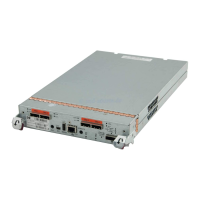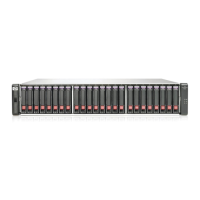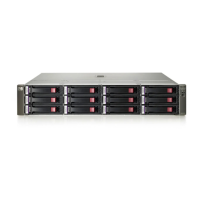48 Alphabetical list of commands
create replication-set
Description Creates a replication set from a specified standard or master volume. If you specify a standard
volume, it is converted to a master volume using default policies for snap-pool creation. You can
optionally use the reserve parameter to set the snap-pool size. The specified volume becomes the
replication set's primary volume.
You can specify a remote volume to be the replication set's secondary volume, or one will be
created. When a replicate snapshot or replicate volume command is issued, data in the primary
volume is replicated to the associated secondary volume.
You can associate the primary volume with a remote system in two ways:
• If the local and remote MCs can communicate, you can specify a vdisk on a remote system. A
master volume and snap-pool are created in the remote vdisk.
• If the local and remote MCs cannot communicate or you want to use an existing
replication-prepared volume on the remote system, you can specify the volume to use as the
secondary volume.
You can also start the initial replication by specifying the snapshot parameter.
If you create a replication set without specifying a replication destination, a partial set is created and
you must use the add replication-volume command to complete the set before you can perform
replication.
IMPORTANT: Before starting this procedure, if you intend to use CHAP to authenticate iSCSI login
requests between the local system and a remote system, do the following:
• Create a one-way CHAP record on each system. On the local system, the CHAP record must refer
to the node name of the remote system. On the remote system, the CHAP record must refer to the
node name of the local system. Both records must use the same secret. (Mutual CHAP is not used
between storage systems. CHAP records' mutual fields can be set but are not used.) To create a
CHAP record, use the create chap-record command.
• After the CHAP records are created, enable CHAP on the primary system, the secondary system,
or both. To enable CHAP, use the set iscsi-parameters command.
If both records don't exist or don't use the same secret, replication-set creation will fail.
If the create transaction fails, a prompt asks if you want to revert the transaction, which undoes any
changes made in attempting to create the replication set. To revert, enter yes; otherwise, enter no.
Syntax
create replication-set
[link-type FC|iSCSI]
[max-queue #]
[noprompt]
[nowait]
[primary-address ip=IPs|wwnn=WWNNs|wwpn=WWPNs]
[priority low|medium|high]
[remote-system system]
[remote-vdisk vdisk]
[remote-volume volume]
[reserve size[B|KB|MB|GB|TB|KiB|MiB|GiB|TiB]]
[secondary-address ip=IPs|wwnn=WWNNs|wwpn=WWPNs]
[set name]
[snapshot snapshot]
primary-volume

